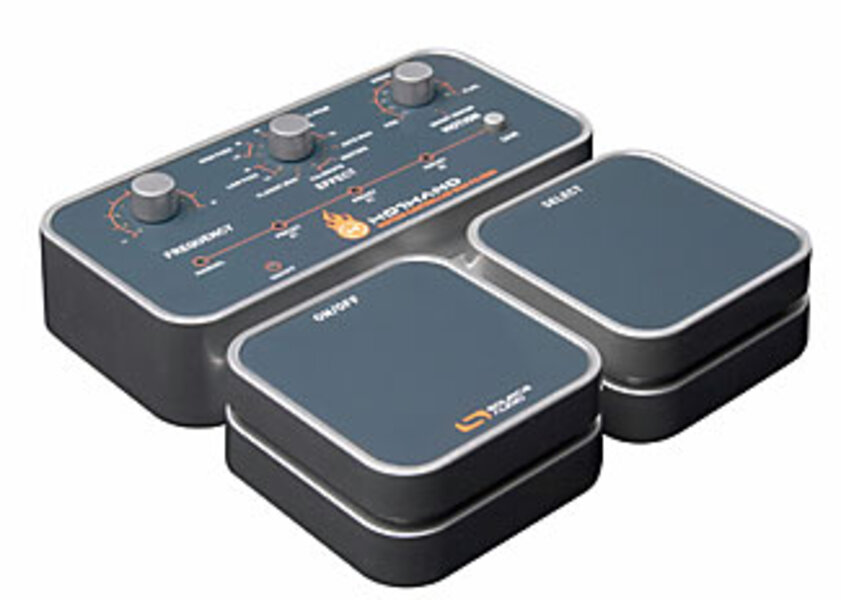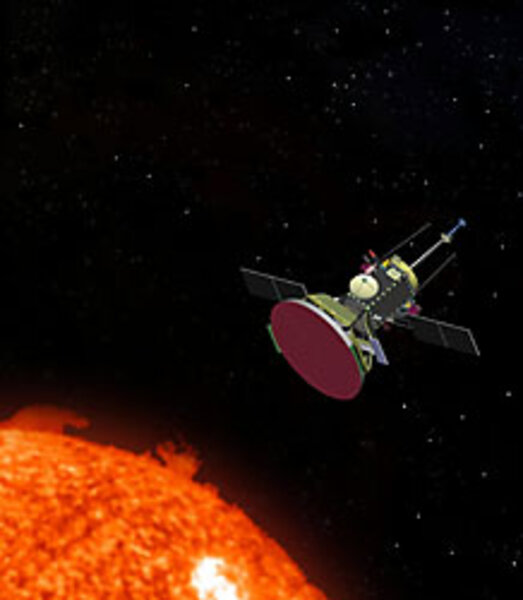Horizons: What's new in sci-tech
Loading...
Wah-wah rings
Ever since Eric Clapton and Jimi Hendrix popularized the wah-wah pedal – a foot-operated device that derives its onomatopoeic name from the reverb sound it creates – guitarists have used their toes to do more than tap along to the beat. Now, a gadget called the Hot Hand allows axe-men to create the same effect by wearing a Green Lantern-like ring on their picking hand.
"Those motions you can make with a foot on the wah-wah pedal are not really quite the same as what you can do with your hand while you're strumming the guitar," explains Bob Chidlaw, chief scientist at Source Audio in Woburn, Mass., where spontaneous guitar jams are all in a day's work.
The digital device relies on a wireless transmitter to translate the guitarist's hand motions into a wah-wah sound (for a demonstration video, visit sourceaudio.net). The traditional wah-wah pedal, connected between the guitar and the amplifier, alters the pitch of the signal. But the pedal, Mr. Chidlaw says, only has a single peak in its frequency response, whereas the digital Hot Hand can create multiple peaks and multiple dips to attain "a very vocal sort of sound." Oddly enough, guitarists can thank air-bag sensors for the technology. The Hot Hand is really an adapted accelerometer chip that measures the acceleration of the hand movement to modulate sound. "You can be a lot faster with your hand in terms of how you modulate the sound," says Chidlaw. In other words, you'll need to be a lord of the ring to become a lord of the strings.
'Extinct' critter scurries back
For 112 years, a type of rodent dubbed the "greater dwarf cloud rat" has been AWOL from the biological record. The last time anyone had seen one of these critters was in 1896. Now, scientists in the United States and Philippines say they have rediscovered the animal – and unlike the earlier specimens, these appeared in the wild.
The researchers say finding an animal this rare in a region under severe threat from human activities gives them some hope that preservation efforts in the Philippines can pay big dividends. The country may have the highest levels of unique biodiversity relative to its size of anyplace on the planet, notes Lawrence Heaney, curator of mammals at Chicago's Field Museum and the project's lead scientist.
The team was surveying small mammals in Mt. Pulag National Park when they found the rat. It lives in a damp, mossy forest about 7,700 feet up the slopes of Mt. Pulag. They found it in treetops some 50 feet above the ground. The rat tips the scales at just under half a pound and is covered with a dense, soft fur that gives it a far more cuddly appearance than the rats many people know. Unlike pests such as the Norway rat, the greater dwarf cloud rat tends to avoid areas where humans live, and is far less likely to inflict the kind of damage to crops and buildings that Norway rats wreak.
Mission to the sun
An ambitious project to cruise through the sun's high-temperature corona has taken a significant step forward. The National Aeronautics and Space Administration has given the green light to develop the $750 million mission that would launch an unmanned spacecraft by 2015. Its goal is to gather up-close data that will help scientists figure out the structure and motions of the sun's magnetic fields, the source and behavior of the energy that heats particles in the corona to between 1 million and 2 million degrees F., and how the charged particles that make up the solar wind are generated and hurtled into space.
The project is one of several US and European missions over the next decade or so to help scientists understand the sun's activity and turn that knowledge into better space-weather forecasts. It also represents an enormous technological challenge. The spacecraft must be engineered to withstand temperatures reaching 2,700 degrees F. and it must survive an environment where it will face intense radiation and high-energy dust particles. NASA has selected the Applied Physics Laboratory at the Johns Hopkins University to design and build the craft.







